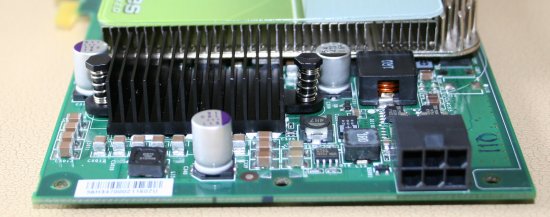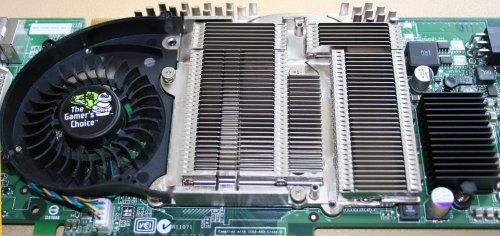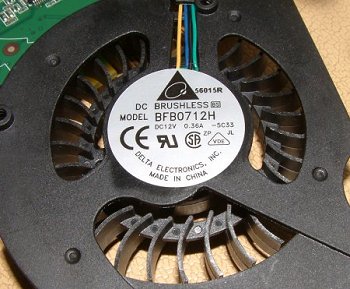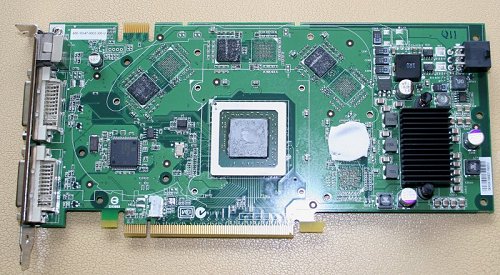BFG GeForce 7800 GTX OC card
BFG Technologies GeForce 7800 GTX OC 256MB PCIeFirst up is the GeForce 7800 GTX offering from the folks at BFG technologies. The very name of the card implies non-default core and memory speeds.

Strip away BFG's signature cooler plate and you're left with a strict reference design, right down to the cooler, power-delivery cooling, and PCB size. What BFG's card has in common with all reference-like designs is dual-DVI outputs (one of which is dual-link spec, allowing you to run, say, Apple's high-resolution 30-inch display without problems), a cooler that takes up only a single slot and covers the RAM modules on the upper side, and SLI compatibility straight out of the box.

Taking a closer look at the front, we see the now-familiar 6-pin PCIe power connector that's still required on high-end boards. NVIDIA reckons the 7800 GTX GPU, based on a whopping 302M transistors, chews up around 100 Watts at full 3D chat, which is around 10% lower than the GeForce 6800 Ultra. The card's width is increased by having a number of power-delivery components on the right-hand side, but, as you will see on the following pages, that's a common theme here.

Another regular arrangement on GeForce 7800 GTX cards is dual DVI outputs and an S-Video port on the left-hand side. It's worth reiterating that BFG's card only takes up a single slot, making it useful for smaller chassis.

Stripping away BFG's cooler cover shows us just how GeForce 7800 GTX cooling takes place. A large aluminium block covers both the GPU and 4 memory DRAM devices on the upper side. Heat is dispersed by being transferred from the GPU, through to the fins, and then pushed out of the right-hand side.

The cooler's fan is actually mounted off-centre. Doing so eliminates the deadspot that can occur when it's situation directly over the GPU. BFG uses a Delta Electronics BFB0712H that spins at a maximum 2,900RPM, produces 39dBa, and moves around 11CFM. The fan's pretty quiet when in full-blown 3D mode, too.

Removing the cooling apparatus reveals the GPU underneath. As you can see on the above picture, BFG has sensibly applied a reasonable amount of TIM between the heatsink and GPU. Speaking of which, BFG's GeForce 7800 GTX derives its OC moniker by having a pre-overclocked core speed of 460MHz as opposed to the reference design's 430MHz. That's around a 7% increase that will be useful when gaming becomes card-limited. To the left of the GPU is a Philips SAA7115HL analogue video capturing (decoding) ASIC, which fits in below the card's fan.

The back of the card has a brace that's required to affix the GPU cooler on the other side. Another 4 GDDR3 DRAM devices are hidden under the elongated aluminium heatsink right above.

A total of 8 256MBit (8M x32) DRAM devices from Samsung are rated at a nominal clock speed of 600MHz (1200MHz DDR), BFG, however, isn't content with that. Instead, the OC card runs with a DRAM speed of 650MHz, or 1300MHz effective. That, again, is above the reference model's 1200MHz, giving this card a really juicy 41.6GB/s memory bandwidth.
In summary, BFG's GeForce 7800 GTX OC is based on the reference design but, and it's a big one, is flashed with a BIOS that pushed up the card's clocks to 460MHz core and 1300MHz memory. Expect it to be 5-7% faster than a reference model in tests where pure card grunt matters most.









